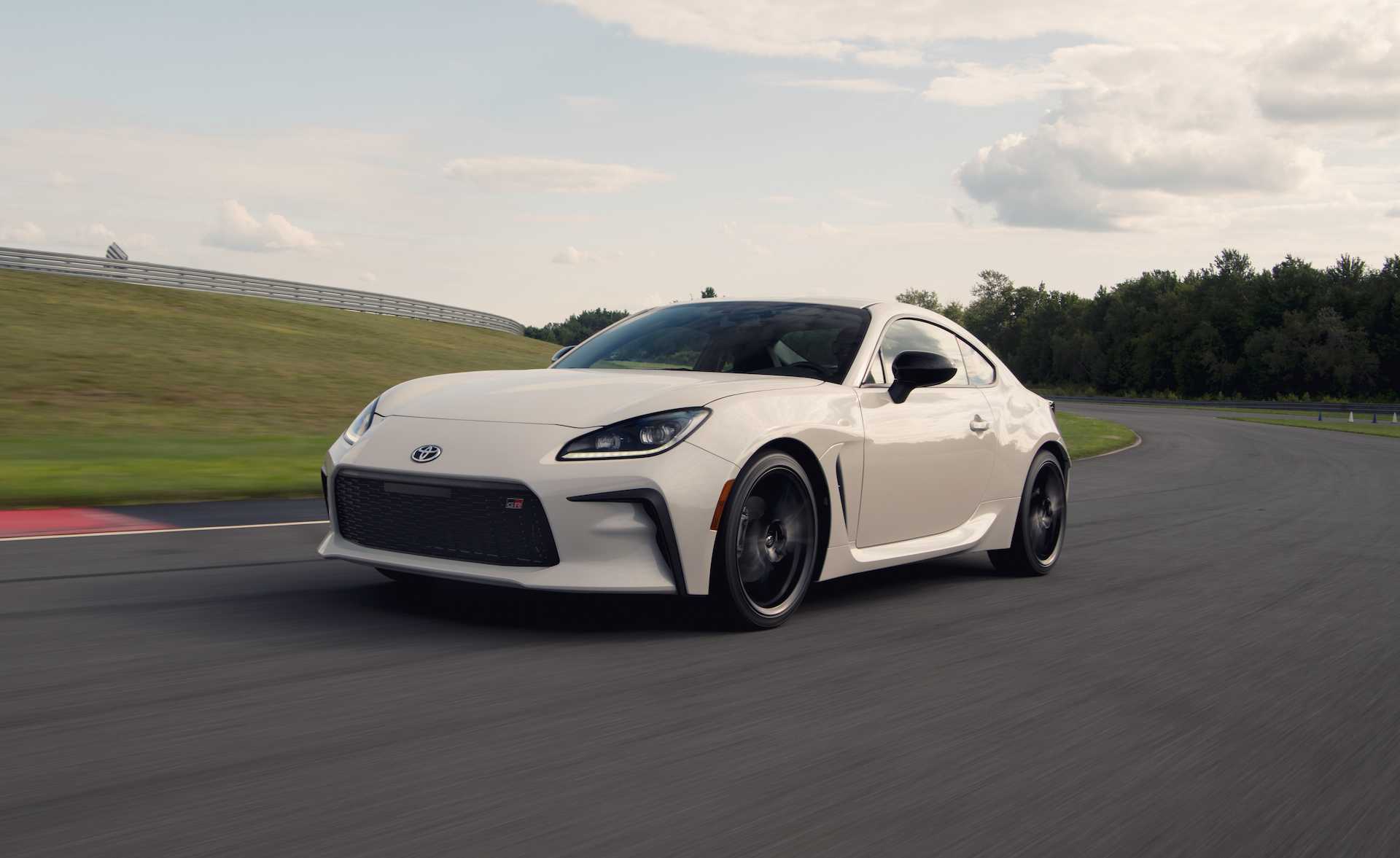Toyota 86 2022 User Guide
The Toyota 86 is a sports car produced by the Japanese automaker Toyota in collaboration with Subaru. The 86, also known as the Toyota GT86 in some markets, was first introduced in 2012 and quickly gained popularity among driving enthusiasts for its rear-wheel drive layout and affordable price.
For the 2022 model year, Toyota introduced an updated version of the 86 with several enhancements. Here are some key features and improvements of the Toyota 86 2022:
- Design: The 2022 Toyota 86 features a more aggressive and dynamic design compared to its predecessor. It showcases a redesigned front grille, reshaped headlights, and a lower, wider stance. The overall appearance emphasizes its sporty nature.
- Engine: The 86 is powered by a 2.4-liter naturally aspirated four-cylinder engine, which is an upgrade from the previous 2.0-liter engine. This new engine produces more horsepower and torque, providing improved acceleration and overall performance.
- Transmission: The 2022 Toyota 86 offers two transmission options. The standard option is a six-speed manual transmission, which provides a more engaging driving experience. Alternatively, there is an available six-speed automatic transmission with paddle shifters for those who prefer automatic shifting.
- Handling and Performance: The Toyota 86 has always been praised for its exceptional handling, and the 2022 model continues that tradition. The updated suspension tuning and chassis improvements enhance stability and responsiveness, allowing drivers to enjoy precise cornering and an exciting driving experience.
- Interior and Technology: Inside the cabin, the 2022 Toyota 86 offers a driver-focused cockpit with supportive seats, high-quality materials, and modern technology features. It includes a touchscreen infotainment system with smartphone integration, Bluetooth connectivity, and available options such as navigation and a premium sound system.
- Safety: The Toyota 86 2022 comes equipped with various safety features to ensure driver and passenger protection. These may include advanced airbags, stability control, traction control, anti-lock brakes, and a rearview camera.
Overall, the Toyota 86 2022 maintains its reputation as an affordable and fun-to-drive sports car, combining engaging performance with sleek design and modern features. It continues to cater to driving enthusiasts who seek a thrilling driving experience without breaking the bank.
Toyota 86 2022 For safe Use User Guide
2022 Toyota 86 For safe Use
Before driving
Observe the following before starting off in the vehicle to ensure the safety of driving.
Floor mats
Use only floor mats designed specifically for vehicles of the same model and model year as your vehicle. Fix them securely in place onto the carpet.
- Insert the retaining hooks (clips) into the floor mat eyelets.
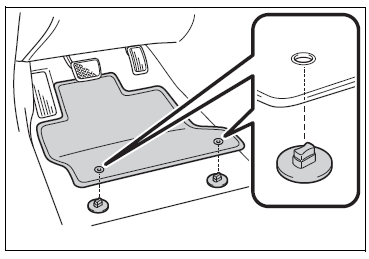
- Turn the upper knob of each retaining hook (clip) to secure the floor mats in place.
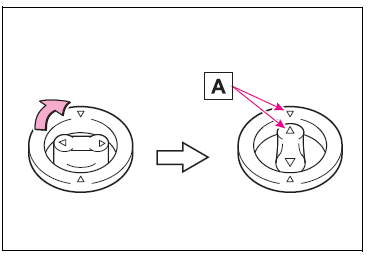
Always align the ![]() marks A
marks A
WARNING
Observe the following precautions. Failure to do so may cause the driver’s floor mat to slip, possibly interfering with the pedals while driving. An unexpectedly high speed may result or it may become difficult to stop the vehicle. This could lead to an accident, resulting in death or serious injury.
- When installing the driver’s floor mat
- Do not use floor mats designed for other models or different model year vehicles, even if they are Toyota Genuine floor mats.
- Only use floor mats designed for the driver’s seat.
- Always install the floor mat securely using the retaining hooks (clips) provided.
- Do not use two or more floor mats on top of each other.
- Do not place the floor mat bottom-side up or upside-down.
WARNING
Before driving
- Check that the floor mat is securely fixed in the correct place with all the provided retaining hooks (clips). Be especially careful to perform this check after cleaning the floor.

- With the engine stopped and the shift lever in P (Automatic transmission) or N (manual transmission), fully depress each pedal to the floor to make sure it does not interfere with the floor mat.
For safe driving
For safe driving, adjust the seat and mirror to an appropriate position before driving.
Correct driving posture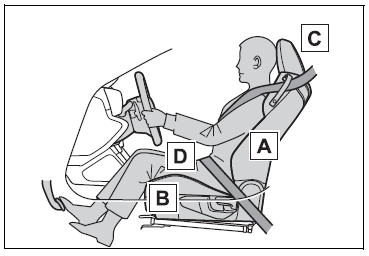
- Adjust the angle of the seatback so that you are sitting straight up and so that you do not have to lean forward to steer.
- Adjust the seat so that you can depress the pedals fully and so that your arms bend slightly at the elbow when gripping the steering wheel.
- Lock the head restraint in place with the center of the head restraint closest to the top of your ears.
- Wear the seat belt correctly.
WARNING
- For safe driving Observe the following precautions. Failure to do so may result in death or serious injury.
- Do not adjust the position of the driver’s seat while driving. Doing so could cause the driver to lose control of the vehicle.
- Do not place a cushion between the driver or passenger and the seatback. A cushion may prevent correct posture from being achieved, and reduce the effectiveness of the seat belt and head restraint.
- Do not place anything under the front seats. Objects placed under the front seats may become jammed in the seat tracks and stop the seat from locking in place. This may lead to an accident and the adjustment mechanism may also be damaged.
- Always observe the legal speed limit when driving on public roads.
- When driving over long distances, take regular breaks before you start to feel tired. Also, if you feel tired or sleepy while driving, do not force yourself to continue driving and take a break immediately.
Correct use of the seat belts
Make sure that all occupants are wearing their seat belts before driving the vehicle. Use a child restraint system appropriate for the child until the child becomes large enough to properly wear the vehicle’s seat belt.
Read all Instructions for For safe Use User Guide
Toyota 86 2022 Child safety User Guide
2022 Toyota 86 Child safety Instructions
Riding with children
Observe the following precautions when children are in the vehicle. Use a child restraint system appropriate for the child, until the child becomes large enough to properly wear the vehicle’s seat belt.
- It is recommended that children sit in the rear seats to avoid accidental contact with the shift lever, wiper switch, etc.
- Use the window lock switch to avoid children operating the power window accidentally.
- Do not let small children operate equipment that may catch or pinch body parts, such as the power window, hood, trunk, seats, etc.
WARNING
- When children are in the vehicle Never leave children unattended in the vehicle, and never allow children to have or use the key. Children may be able to start the vehicle or shift the vehicle into neutral. There is also a danger that children may injure themselves by playing with the windows or other features of the vehicle. In addition, heat build-up or extremely cold temperatures inside the vehicle can be fatal to children
Child restraint systems
Before installing a child restraint system in the vehicle, there are precautions that need to be observed, different types of child restraint systems, as well as installation methods, etc., written in this manual.
Use a child restraint system when riding with a small child that cannot properly use a seat belt. For the child’s safety, install the child restraint system to a rear seat. Be sure to follow the installation method that is in the operation manual enclosed with the restraint system.
Table of contents
Points to remember:
Child restraint system:
When using a child restraint system
Child restraint system installation method
- Fixed with a seat belt:
- Fixed with child restraint LATCH anchors:
- Using an anchor bracket (for top tether strap):
Points to remember
The laws of all 50 states of the U.S.A. as well as Canada now require the use of child restraint systems.
- Prioritize and observe the warnings, as well as the laws and regulations for child restraint systems.
- Use a child restraint system until the child becomes large enough to properly wear the vehicle’s seat belt.
- Choose a child restraint system that suits your vehicle and is appropriate to the age and size of the child.
WARNING
When a child is riding
Observe the following precautions. Failure to do so may result in death or serious injury.
- For effective protection in automobile accidents and sudden stops, a child must be properly restrained, using a seat belt or child restraint system which is correctly installed. For installation details, refer to the operation manual enclosed with the child restraint system. General installation instruction is provided in this manual.
- Toyota strongly urges the use of a proper child restraint system that conforms to the weight and size of the child, installed on the rear seat. According to accident statistics, the child is safer when properly restrained in the rear seat than in the front seat.
- Holding a child in your or someone else’s arms is not a substitute for a child restraint system. In an accident, the child can be crushed against the windshield or between the holder and the interior of the vehicle.
Handling the child restraint system
If the child restraint system is not properly fixed in place, the child or other passengers may be seriously injured or even killed in the event of sudden braking, sudden swerving, or an accident.
- If the vehicle were to receive a strong impact from an accident, etc., it is possible that the child restraint system has damage that is not readily visible. In such cases, do not reuse the restraint system.
- Make sure you have complied with all installation instructions provided with the child restraint system manufacturer and that the system is properly secured.
- Keep the child restraint system properly secured on the seat even if it is not in use. Do not store the child restraint system unsecured in the passenger compartment.
- If it is necessary to detach the child restraint system, remove it from the vehicle or store it securely in the trunk.
Child restraint system
Types of child restraint system installation methods
Confirm with the operation manual enclosed with the child restraint system about the installation of the child restraint system.
Read all Instructions for Child safety User Guide
Toyota 86 2022 Emergency assistance User Guide
2022 Toyota 86 Emergency assistance
Safety Connect
Safety Connect is a subscription-based telematics service that uses Global Positioning System (GPS) data and embedded cellular technology to provide safety and security features to subscribers. Safety Connect is supported by Toyota’s designated response center, which operates 24 hours per day, 7 days per week. Safety Connect service is available by subscription on select, telematics hard-ware-equipped vehicles. By using the Safety Connect service, you are agreeing to be bound by the Telematics Subscription Service Agreement and its Terms and Conditions, as in effect and amended from time to time, a current copy of which is available at Toyota.com in the United States and Toy-ota.ca in Canada. All use of the Safety Connect service is subject to such then-applicable Terms and Conditions.System componentsServices
System components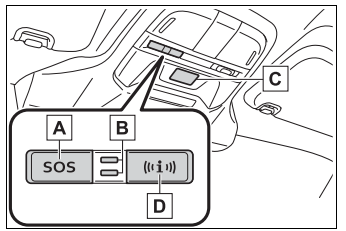
- “SOS” button
- LED light indicators
- Microphone
- “i” button
Multimedia system screen
As with the “i” button, the “Roadside Assist” icon displayed on the home screen of the multimedia system can be used to operate Enhanced Roadside Assistance.
Services
Subscribers have the following Safety Connect services available:
- Automatic Collision Notification*
- Helps drivers receive a necessary response from emergency service providers.
- U.S. Patent No. 7,508,298 B2
- Stolen Vehicle Location
- Helps drivers in the event of vehicle theft.
- Emergency Assistance Button (“SOS” button) Connects drivers to response-center support.
Enhanced Roadside Assistance (“i” button) Provides drivers with various on-road assistance.
Subscription
After you have signed the Telematics Subscription Service Agreement and are enrolled, you can begin receiving services.
A variety of subscription terms are available for purchase. Contact your Toyota dealer, call the following appropriate Customer Experience Center or push the “SOS” button in your vehicle for further subscription details.
- The United States 1-800-331-4331
- Canada 1-888-869-6828
Safety Connect Services Information
- Phone calls using the vehicle’s Bluetooth® technology will not be possible when Safety Connect is active and in use.
- Safety Connect is available beginning Fall 2009 on select Toyota models (in the contiguous United States only). Contact with the Safety Connect response center is dependent upon the telematics device being in operative condition, cellular connection availability, and GPS satellite signal reception, which can limit the ability to reach the response center or receive emergency service support. Enrollment and Telematics Subscription Service Agreement are required. A variety of subscription terms are available; charges vary by subscription term selected and location.
- Automatic Collision Notification, Emergency Assistance, and Stolen Vehicle Location are available in the United States, including Hawaii and Alaska, and Canada, and Enhanced Roadside Assistance are available in the United States and Canada.
- Automatic Collision Notification, Emergency Assistance, Stolen Vehicle, and Enhanced Road Assistance are not available in the U.S. Virgin Islands.
For vehicles first sold in the U.S. Virgin Islands, no Safety Connect services will function in or outside the U.S. Virgin Islands. - Safety Connect services are not subject to section 255 of the Telecommunications Act and the device is not TTY compatible.
Languages
The Safety Connect response center will offer support in multiple languages. The Safety Connect system will offer voice prompts in English and French. Please indicate your language of choice when enrolling.
When contacting the response center
You may be unable to contact the response center if the network is busy.
Safety Connect LED light Indicators
When the engine switch is turned to “ON”, the red indicator light and the green indicator light will illuminate and then turn off. Then, the green indicator light will illuminate to indicate that the service is active.
The following indicator light patterns indicate specific system usage conditions:
- Green indicator light on = Active service
- Green indicator light flashing = Safety Connect call in process
- Red indicator light on (except at vehicle start-up) = System malfunction (contact your Toyota dealer)
- No indicator light (off) = Safety Connect service not active
Safety Connect services
Automatic Collision Notification
- In case of either airbag deployment or severe rear-end collision, the system is designed to automatically call the response center. The responding agent receives the vehicle’s location and attempts to speak with the vehicle occupants to assess the level of emergency. If the occupants are unable to communicate, the agent automatically treats the call as an emergency, contacts the nearest emergency services provider to describe the situation, and requests that assistance be sent to the location.
Stolen Vehicle Location
- If your vehicle is stolen, Safety Connect can work with local authorities to assist them in locating and recovering the vehicle. After filing a police report, call the Customer Experience Center at 1-800-331-4331 in the United States or 1-888-869-6828 in Canada, and follow the prompts for Safety Connect to initiate this service. In addition to assisting law enforcement with recovery of a stolen vehicle, Safety-Connect- equipped vehicle location data may, under certain circumstances, be shared with third parties to locate your vehicle. Further information is available at Toyota.com in the United States and Toyota.ca in Canada.
Read all Instructions for Emergency assistance User Guide
Toyota 86 2022 Theft deterrent system User Guide
2022 Toyota 86 Theft deterrent system
Engine immobilizer system
The vehicle’s keys have built-in transponder chips that prevent the engine from starting if a key has not been previously registered in the vehicle’s onboard computer. Never leave the keys inside the vehicle when you leave the vehicle. This system is designed to help prevent vehicle theft but does not guarantee absolute security against all vehicle thefts.
Operating the system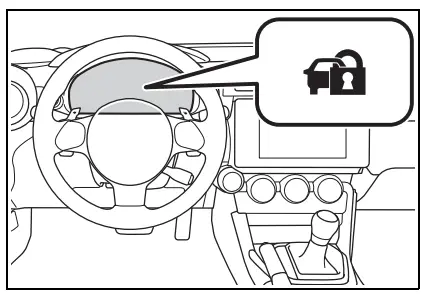
- The indicator light flashes after the engine switch have been turned off to indicate that the system is operating.
- The indicator light stops flashing after the engine switch has been turned to ACC or ON to indicate that the system has been canceled.
System maintenance
The vehicle has a maintenance-free type engine immobilizer system.
Conditions that may cause the system to malfunction
- If the grip portion of the key is in contact with a metallic object
- If the key is in close proximity to or touching a key registered to the security system (key with a built-in transponder chip) of another vehicle
NOTICE
To ensure the system operates correctly
Do not modify or remove the system. If modified or removed, the proper operation of the system cannot be guaranteed.
Alarm
The alarm’s default setting is set to off. To use the alarm, perform the activating the alarm system procedures. The alarm uses light and sound to give an alert when an intrusion is detected. The alarm is triggered in the following situations when the alarm is set:
- A locked door or trunk is unlocked or opened in any way other than using the entry function or wireless remote control.
- The hood is opened.
Setting/canceling/stop-ping the alarm system
Items to check before locking the vehicle
To prevent unexpected trigger-ing of the alarm and vehicle theft, make sure of the following:
- Nobody is in the vehicle.
- The windows are closed before the alarm is set.
- No valuables or other personal items are left in the vehicle.
Setting
Items to check before locking the vehicle To prevent unexpected triggering of the alarm and vehicle theft, make sure of the following:
- Nobody is in the vehicle.
- The windows are closed before the alarm is set.
- No valuables or other personal items are left in the vehicle.
Setting
Close the doors, trunk, and hood, and lock both side doors using the entry function or wireless remote control. The system will set automatically after 30 seconds. The indicator light changes from being on to flashing when the system is set.
Canceling or stopping
Do one of the following to deactivate or stop the alarms:
- Unlock the doors or open the trunk using the entry function or wireless remote control.
- Turn the engine switch to ACC or ON, or start the engine.
Activating/deactivating the alarm system
- Check that both side doors and the trunk are closed.
- Turn the engine switch to ON.
- Open the driver’s door while pressing and holding
 on to the door lock switch and continue to press
on to the door lock switch and continue to press  for approximately 10 seconds after the driver’s door has opened.
for approximately 10 seconds after the driver’s door has opened. - The alarm system changes between activated and deactivated as follows.

| Alarm status |
Horn |
Multi-information dis- play |
| Deactivated | Sounds twice | “AL OFF” |
| Activated | Sounds once | “AL ON” |
System maintenance
The vehicle has a maintenance-free type alarm system.
Opening and closing the trunk
- If the alarm setting operations are performed with the trunk left open, the alarm will not be set. After closing the trunk, the alarm is set after 30 seconds or more elapse.
- When the trunk is unlocked using the entry function or wireless remote control while the alarm is set, the alarm goes into standby mode. After closing the trunk, the alarm is set again after 30 seconds or more elapse
Read all Instructions for Theft deterrent system User Guide
Toyota 86 2022 Instrument cluster User Guide
2022 Toyota 86 Instrument cluster
Warning lights and indicators
The warning lights and indicators on the instrument cluster and overhead console inform the driver of the status of the vehicle’s various systems.
Warning lights and indicators displayed on the instrument cluster
For the purpose of explanation, the following illustrations display all warning lights and indicators illuminated.
Warning lights
Warning lights inform the driver of malfunctions in the indicated vehicle systems.
 Brake system warning light*1
Brake system warning light*1  Brake system warning light*1
Brake system warning light*1  High coolant temperature warning light*1
High coolant temperature warning light*1 Charging system warning light*1
Charging system warning light*1 Low engine oil pressure warning light*1
Low engine oil pressure warning light*1 Malfunction indicator lamp*1
Malfunction indicator lamp*1 Malfunction indicator lamp*1
Malfunction indicator lamp*1 SRS warning light*1
SRS warning light*1 ABS warning light*1
ABS warning light*1 ABS warning light*1
ABS warning light*1 Electric power steering system warning light*1
Electric power steering system warning light*1 Slip indicator*1
Slip indicator*1 Automatic transmission fluid temperature warning light (if equipped)
Automatic transmission fluid temperature warning light (if equipped)  Open door warning light
Open door warning light Low fuel level warning light*1
Low fuel level warning light*1  Driver’s and front passenger’s seat belt reminder light*1, 2
Driver’s and front passenger’s seat belt reminder light*1, 2  Rear passengers’ seat belt reminder lights*1,(yellow)
Rear passengers’ seat belt reminder lights*1,(yellow) The conventional Cruise Control indicator (if equipped)
The conventional Cruise Control indicator (if equipped) BSD/RCTA warning light (if equipped)
BSD/RCTA warning light (if equipped) SRH warning light (if equipped)
SRH warning light (if equipped)  RAB warning light (if equipped)
RAB warning light (if equipped)  LED headlight warning light
LED headlight warning light  Automatic headlight leveling system warning light
Automatic headlight leveling system warning light  Master warning light*1
Master warning light*1  EyeSight warning light (if equipped)
EyeSight warning light (if equipped)  Tire pressure warning light*1
Tire pressure warning light*1
Read all Instructions for Instrument cluster User Guide
Toyota 86 2022 Key information User Guide
2022 Toyota 86 Key information
The keys
The following keys are provided with the vehicle.
- Electronic keys
- Operating the smart key system
- Operating the wireless remote control function
- Mechanical keys
- Key number plate
When riding in an aircraft
When bringing an electronic key onto an aircraft, make sure you do not press any buttons on the electronic key while inside the aircraft cabin. If you are carrying an electronic key in your bag etc., ensure that the buttons are not likely to be pressed accidentally. Pressing a button may cause the electronic key to emit radio waves that could interfere with the operation of the aircraft.
Electronic key battery depletion
- The standard battery life is 1 to 2 years.
- If the battery becomes low, an alarm will sound in the cabin and a message will be shown on the multi-information display when the engine is stopped.
- To reduce key battery depletion when the electronic key is to not be used for long periods of time, set the electronic key to the battery-saving mode.
- As the electronic key always receives radio waves, the battery will become depleted even if the electronic key is not used.
- The following symptoms indicate that the electronic key battery may be depleted. Replace the battery when necessary.
- The smart key system or the wireless remote control does not operate.
- The detection area becomes smaller.
- The LED indicator on the key surface does not turn on.
- To avoid serious deterioration, do not leave the electronic key within 3 ft. (1 m) of the following electrical appliances that produce a magnetic field:
- TVs
- Personal computers
- Cellular phones, cordless phones, and battery chargers
- Recharging cellular phones or cordless phones
- Table lamps
- Induction cookers
- Replacing the battery
Confirmation of the registered key number
The number of keys already registered to the vehicle can be confirmed. Ask your Toyota dealer for details.
NOTICE
To prevent key damage
Do not drop the keys, subject them to strong shocks or bend them
NOTICE
To prevent key damage
- Do not drop the keys, subject them to strong shocks or bend them.
- Do not expose the keys to high temperatures for long periods of time.
- Do not get the keys wet or wash them in an ultrasonic washer etc.
- Do not attach metallic or magnetic materials to the keys or place the keys close to such materials.
- Do not disassemble the keys.
- Do not attach a sticker or anything else to the surface of the electronic key.
- Do not place the keys near objects that produce magnetic fields, such as TVs, audio systems, and induction cookers.
Carrying the electronic key on your person
Carry the electronic key 3.9 in. (10 cm) or more away from electric appliances that are turned on Radio waves emitted from electric appliances within 3.9 in. (10 cm) of the electronic key may interfere with the key, causing the key to not function properly.
In case of a smart key system malfunction or other key-related problems
When an electronic key is lost
Wireless remote control
The electronic keys are equipped with the following wireless remote control:
- Locks the doors
- Unlocks the doors
- Opens the trunk
- Sounds the alarm
Panic mode
When ![]() is pressed for longer than about one second, an alarm will sound intermittent and the vehicle lights will flash to deter any person from trying to break into or damage your vehicle?
is pressed for longer than about one second, an alarm will sound intermittent and the vehicle lights will flash to deter any person from trying to break into or damage your vehicle?
Read all Instructions for Key information User Guide
Toyota 86 2022 Opening, closing and locking the doors User Guide
2022 Toyota 86 Opening, closing and locking the doors
Doors
Unlocking and locking the doors from the outside
Smart key system
Carry the electronic key to enable this function.
- Grip the driver’s door handle to unlock the door. Grip the passenger’s door handle to unlock all the doors.*
- Make sure to touch the sensor on the back of the handle.
- The doors cannot be unlocked for 3 seconds after the doors are locked.
- The door unlocks settings can be changed.
- Touch the lock sensor (indentation on the side of the door handle) to lock the doors.
- Check that the door is securely locked.
Wireless remote control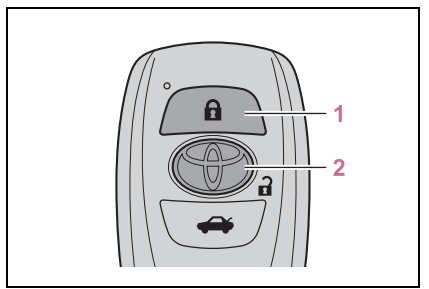
- Locks both side doors
Check that the door is securely locked. - Unlocks both side doors
Pressing the button unlocks the driver’s door. Pressing the button again within 3 seconds unlocks the other door.
Side window open/close function linked to door operation
- In order to make opening and closing the doors easier, completely closed windows are linked to door operations. Therefore, when a door is opened, its window opens slightly. When a door is closed, its window closes completely.
- However, if the battery has been discharged or is disconnected, this function will not operate.
Operation signals
- A buzzer sounds and the emergency flashers flash to indicate that the doors have been locked/unlocked. (Locked: once; Unlocked: twice)
When the door cannot be locked by the lock sensor on the surface of the door handle
- If the doors cannot be locked by touching the lock sensor with a finger, touch the lock sensor with the palm of your hand. If you are wearing gloves, remove them.

Door lock buzzer
- If an attempt to lock the doors using the entry function or wireless remote control is made when a door is not fully closed, a buzzer will sound continuously for 5 seconds. Fully close the door to stop the buzzer, and lock the doors again.
Alarm
- Locking the doors will set the alarm system.
- Conditions affecting the operation of the smart key system or wireless remote control
- If the smart key system or the wireless remote control does not operate properly Use the mechanical key and/or inside lock buttons to lock and unlock the doors.
- Replace the key battery with a new one if it is depleted.
- If the battery is discharged The doors cannot be locked and unlocked using the smart key system or wireless remote control. Lock or unlock the doors using the mechanical key
Customization
- Some functions can be customized.
Read all Instructions for Opening, closing and locking the doors User Guide
Toyota 86 2022 Adjusting the seats User Guide
2022 Toyota 86 How to Adjusting the seats
Front seats
Adjustment procedure
- Seat position adjustment lever
- Seatback angle adjustment lever
- Vertical height adjustment lever (driver’s side only)
- Seatback fold lever
Getting in and out of the rear seats
To get in and out of the rear seats, use the seatback angle adjustment lever or seatback fold lever.
Before getting in or out of the rear seats
Remove the seat belt from the seat belt guide.
When getting in or out of the rear seats
- Driver’s side
Pull the seatback fold lever ( A ) or lift the seatback angle adjust-ment lever ( B ).The seatback will fold forward.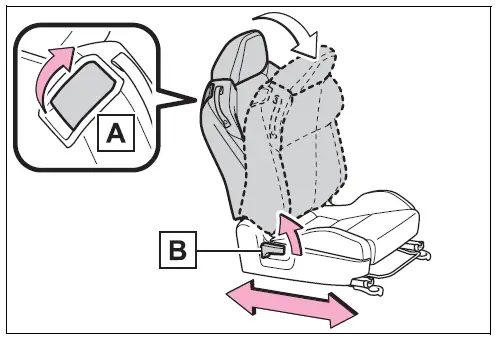
- Front passenger’s side
Pull the seatback fold lever ( A ) or lift the seatback angle adjust-ment lever ( B ). The seatback will fold forward. The seat can be slid forward and backward.
- After getting in or out of the rear seats
Return the seatback to the upright position until the seat locks.
Front passenger seat only: The seat will lock in position at the point where the seatback reaches the upright position. - Seat dust cover
Always remove the seat dust cover that may be attached at the time of purchase before using the seat.
WARNING
Seat adjustment
- To reduce the risk of sliding under the lap belt during a collision, do not recline the seat more than necessary.
- If the seat is too reclined, the lap belt may slide past the hips and apply restraint forces directly to the abdomen, or your neck may contact the shoulder belt, increas-ing the risk of death or serious injury in the event of an accident.
- Adjustments should not be made while driving as the seat may unexpectedly move and cause the driver to lose control of the vehicle.
- After adjusting the seat, make sure that the seat is locked in position.
- Take care not to hit passengers with the seat. When sliding the seat rearward, make sure not to squash the legs of the rear pas-sengers.
- When returning the seatback upright, perform seatback angle adjustment while holding down the seatback.
- Do not pull on or use the seat belt guide to adjust or fold the front seat.Do not put your hands under the seat or near the moving parts to avoid injury. Fingers or hands may become jammed in the seat mechanism.
- When driving the vehicle
- Never operate the seat position adjustment lever, seatback angle adjustment lever or seatback fold lever. Doing so could cause an accident resulting in death or seri-ous injury.
Getting in and out of the rear seats
- When getting in or out of the rear seats, make sure not to get your hands, legs, etc. squashed in the movable or connecting parts.
- When getting in or out of the rear seats, make sure not to trip on the seat rails.
- After getting in or out of the rear seats, always make sure the front seat is locked in position.
When operating the front seat from the rear seat
- Make sure that no passenger is seated in the front seat.
NOTICE
- When adjusting a front seat
When adjusting a front seat, make sure that the head restraint does not contact the headliner. Otherwise, the head restraint and head liner may be damaged. - When getting in and out the vehicle
Do not rub your back against the side support pad of the backrest. Otherwise, the surface of the side support pad is damaged early. You can move the seat back to prevent contact.
Read all Instructions for Adjusting the seats User Guide
Toyota 86 2022 Adjusting the steering wheel,mirrorsand and Opening, closing the windows and moon roof User Guide
Steering Wheel: 2022 Toyota 86 | Power Windows User Manual
Steering wheel
Adjustment procedure
- Hold the steering wheel and push the lever down.
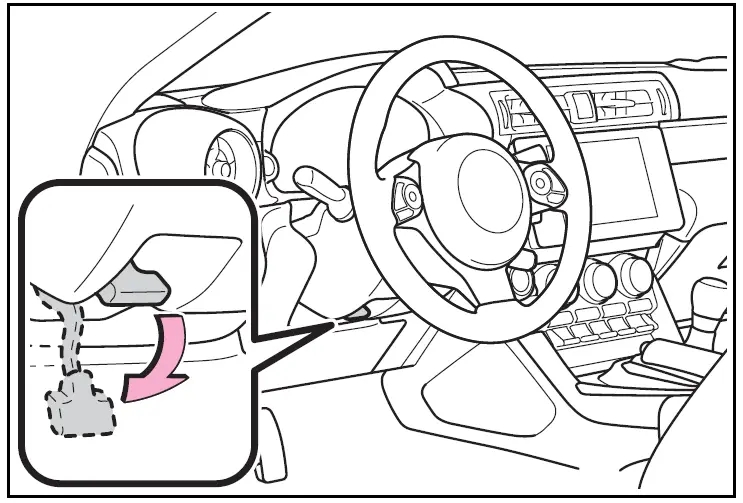
- Adjust to the ideal position by moving the steering wheel horizontally and vertically After adjustment, pull the lever up to secure the steering wheel.

WARNING
- Caution while driving
Do not adjust the steering wheel while driving. Doing so may cause the driver to mishandle the vehicle and cause an accident, resulting in death or serious injury. - After adjusting the steering wheel
Make sure that the steering wheel is securely locked. Otherwise, the steering wheel may move suddenly, possibly causing an accident, and resulting in death or serious injury. Also, the horn may not sound if the steering wheel is not securely locked.
Horn
To sound the horn, press on or close to the mark.
mark.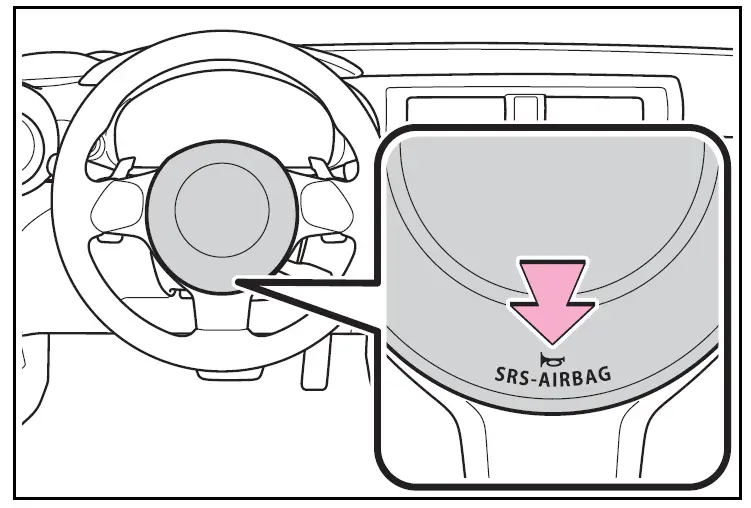
Inside rearview mirror
The rearview mirror’s position can be adjusted to enable sufficient confirmation of the rearview.
Adjusting the height of the rearview mirror
The height of the rearview mirror can be adjusted to suit your driving posture.
Adjust the height of the rearview mirror by moving it up and down.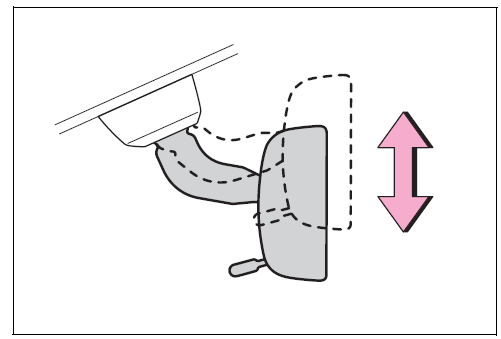
WARNING
Caution while driving
Do not adjust the position of the mirror while driving. Doing so may lead to mishandling of the vehicle and cause an accident, resulting in death or serious injury.
Anti-glare function
Reflected light from the headlights of vehicles behind can be reduced by operating the lever.
- Normal position
- Anti-glare position
Outside rearview mirrors
The rear view mirror’s position can be adjusted to enable sufficient confirmation of the rear view.
WARNING
Important points while driving
Observe the following precautions while driving. Failure to do so may result in loss of control of the vehicle and cause an accident, resulting in death or serious injury.
- Do not adjust the mirrors while driving.
- Do not drive with the mirrors folded.
- Both the driver and passenger side mirrors must be extended and properly adjusted before driving.
Read all Instructions for Adjusting the steering wheel and mirrors User Guide
Toyota 86 2022 Before driving User Guide
Toyota 86 2022 Before driving User Guide
Driving the vehicle
The following procedures should be observed to ensure safe driving:
Driving procedure
Starting the engine
Automatic transmission
- With the brake pedal depressed, shift the shift lever to D.
- Release the parking brake
- Gradually release the brake pedal and gently depress the accelerator pedal to accelerate the vehicle.
Manual transmission
- While depressing the clutch pedal, shift the shift lever to 1.
- Release the parking brake.
- Gradually release the clutch pedal. At the same time, gently depress the accelerator pedal to accelerate the vehicle.
Stopping
Automatic transmission
- With the shift lever in D, depress the brake pedal.
- If necessary, set the parking brake. If the vehicle is to be stopped for an extended period of time, shift the shift lever to P.
Manual transmission
- While depressing the clutch pedal, depress the brake pedal.
- If necessary, set the parking brake. If the vehicle is to be stopped for an extended period of time, shift the shift lever to N.
Parking the vehicle
Automatic transmission
- With the shift lever in D, depress the brake pedal to stop the vehicle completely.
- Set the parking brake shift the shift lever to P. Check the parking brake indicator is illuminated.
- Press the engine switch to stop the engine.
- Slowly release the brake pedal.
- Lock the door, making sure that you have the key on your person. If parking on a hill, block the wheels as needed.
Manual transmission
- While depressing the clutch pedal, depress the brake pedal to stop the vehicle completely.
- Set the parking brake. (.156)
Check that the parking brake indicator is illuminated. - Shift the shift lever to N.
If parking on a hill, shift the shift lever to 1 or R and block the wheels as needed. - Press the engine switch to stop the engine.
- Slowly release the brake pedal.
- Lock the door, making sure that you have the key on your person.
Starting off on a steep uphill
Automatic transmission
- Make sure that the parking brake is set and shift the shift lever to D.
- Gently depress the accelerator pedal.
- Release the parking brake.
Manual transmission
- Make sure that the parking brake is set and shift the shift lever to 1.
- Lightly depress the accelerator pedal at the same time as gradually releasing the clutch pedal.
- Release the parking brake.
When starting off on an uphill
The hill-start assist control will activate
Driving in the rain
- Drive carefully when it is raining, because visibility will be reduced, the windows may become fogged up, and the road will be slippery.
- Drive carefully when it starts to rain because the road surface will be especially slippery.
- Refrain from high speeds when driving on an expressway in the rain, because there may be a layer of water between the tires and the road surface, preventing the steering and brakes from operating properly.
Engine speed while driving (vehicles with an automatic transmission)
In the following conditions, the engine speed may become high while driving. This is due to automatic up-shifting control or down-shifting implementation to meet driving conditions. It does not indicate sudden acceleration.
Read all Instructions for Before driving User Guide
Toyota 86 2022 Driving procedures User Guide
Toyota 86 2022 Driving procedures User Guide
Engine (ignition) switch
Performing the following operations when carrying the electronic key on your person starts the engine or changes engine switch modes.
Starting the engine
- Check that the parking brake is set.
- Check that the shift lever is in P (automatic transmission) or N (manual transmission).
- Firmly depress the brake pedal (automatic transmission) or clutch pedal (manual transmission)
 and a message will be displayed on the multi-information display. If it is not displayed, the engine cannot be started.
and a message will be displayed on the multi-information display. If it is not displayed, the engine cannot be started. - Press the engine switch shortly and firmly.
When operating the engine switch, one short, firm press is enough. It is not necessary to press and hold the switch. The engine will crank until it starts or for up to 10 seconds, whichever is less. Continue depressing the brake pedal (automatic transmission) or clutch pedal (manual transmission) until the engine is completely started. The engine can be started from any engine switch mode.
If the engine does not start
- The engine immobilizer system may not have been deactivated. Contact your Toyota dealer.
- If a message related to start-up is shown on the multi-information display, read the message and follow the instructions.
If the battery is discharged
- The engine cannot be started using the smart key system. Refer to restart the engine.
- Electronic key battery depletion
- Conditions affecting operation
- Notes for the entry function
Steering lock function
- After turning the engine switch off and opening and closing the doors, the steering wheel will be locked due to the steering lock function. Operating the engine switch again automatically cancels the steering lock.
- When the steering lock cannot be released, “Locked. Push Ignition Switch While Turning Steering Wheel” will be displayed on the multi-information display. Check that the shift lever is in P (automatic transmission) or N (manual transmission). Press the engine switch while turning the steering wheel left and right
- To prevent the steering lock motor from overheating, the operation of the motor may be suspended if the engine is turned on and off repeatedly in a short period of time. In this case, refrain from operating the engine switch. After about 10 seconds, the steering lock motor will resume functioning.
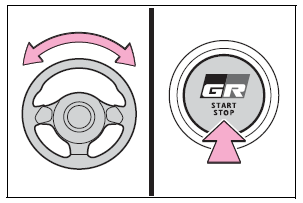
When “Keyless Access System Disabled Check Owner’s Manual” is displayed on the multi-information display
The system may be malfunction. Have the vehicle inspected by your Toyota dealer immediately.
Electronic key battery
Operation of the engine switch
- If the switch is not pressed shortly and firmly, the engine switch mode may not change or the engine may not start.
- If attempting to restart the engine immediately after turning the engine switch off, the engine may not start in some cases. After turning the engine switch off, please wait more than 10 seconds before restarting the engine.
- If the smart key system has been disabled
Immediately after reconnecting the battery terminals due to replacing the battery and so forth
The engine may not start. If this occurs, turn the engine switch to ON, and start the engine after waiting at least 10 seconds. Idling may be unstable immediately after the engine starts, however, this is not a malfunction.
WARNING
- When starting the engine Always start the engine while sitting in the driver’s seat. Do not depress the accelerator pedal while starting the engine under any circumstances. Doing so may cause an accident resulting in death or serious injury.
- Caution while driving If engine failure occurs while the vehicle is moving, do not lock or open the doors until the vehicle reaches a safe and complete stop. Activation of the steering lock in this circumstance may lead to an accident, resulting in death or serious injury.
NOTICE
- When starting the engine
- Do not race a cold engine.
- If the engine becomes difficult to start or stalls frequently, have your vehicle checked by your Toyota dealer immediately.
- Vehicles with an automatic transmission: Do not shift the shift lever while the starter is operating.
NOTICE
Symptoms indicating a malfunction with the engine switch If the engine switch seems to be operating somewhat differently than usual, such as the switch sticking slightly, there may be a malfunction. Contact your Toyota dealer immediately.
Stopping the engine
Automatic transmission
- Stop the vehicle completely.
- Set the parking brake and shift the shift lever to P. Check the parking brake indicator is illuminated.
- Press the engine switch. The engine will stop, and the meter display will be extinguished.
- Release the brake pedal and check that “ACCESSORY” or “IGNITION ON” is not shown on the meters.
Manual transmission
- Stop the vehicle completely.
- Set the parking brake. Check the parking brake indicator is illuminated.
- Shift the shift lever to N.
- Press the engine switch.
The engine will stop, and the meter display will be extinguished. Release the brake pedal and check that “ACCESSORY” or “IGNITION ON” is not shown on the meters.
WARNING
Stopping the engine in an emergency
If you want to stop the engine in an emergency while driving the vehicle, press and hold the engine switch for more than 2 seconds, or press it briefly 3 times or more in succession. However, do not touch the engine switch while driving except in an emergency. Turning the engine off while driving will not cause loss of steering or braking control, but the power assist to these systems will be lost. This will make it more difficult to steer and brake, so you should pull over and stop the vehicle as soon as it is safe to do so.
Read all Instructions for Driving procedures User Guide
Toyota 86 2022 Operating the lights and wipers User Guide
Toyota 86 2022 Operating the lights and wipers User Guide
Headlight switch
The headlights can be operated manually or automatically.
Operating instructions
Operating the![]() switch turns on the lights as follows:
switch turns on the lights as follows:
For the U.S.A.
 The headlights, parking/ daytime running lights and all the lights listed above turn on and off automatically. (When the engine switch is in ON.)
The headlights, parking/ daytime running lights and all the lights listed above turn on and off automatically. (When the engine switch is in ON.) The side marker, parking, tail, license plate, instrument panel lights and daytime running lights turn on.
The side marker, parking, tail, license plate, instrument panel lights and daytime running lights turn on. The headlights and all lights listed above (except daytime running lights) turn on.
The headlights and all lights listed above (except daytime running lights) turn on.- OFF The daytime running lights turn on.
For Canada
 The headlights, parking/ daytime running lights and all the lights listed above turn on and off automatically. (When the engine switch is in ON.)
The headlights, parking/ daytime running lights and all the lights listed above turn on and off automatically. (When the engine switch is in ON.) The side marker, parking, tail, license plate, instrument panel lights and daytime running lights
The side marker, parking, tail, license plate, instrument panel lights and daytime running lights - turn on.
 The headlights and all lights listed above (except daytime running lights) turn on.
The headlights and all lights listed above (except daytime running lights) turn on.
AUTO mode can be used when
- The engine switch is in ON.
Daytime running light system
- The daytime running lights illuminate using the same lights as the parking lights and illuminate brighter than the parking lights.
- To make your vehicle more visible to other drivers during daytime driving, the daytime running lights turn on automatically when all of the following conditions are met. (The daytime running lights are not designed for use at night.)
- The engine is running
- The shift lever is shifted out of P (vehicles with an automatic transmission)
- The parking brake is released
- The headlight switch is in the (U.S.A. only),
 or
or * position
* position
When the surroundings are bright The daytime running lights remain on after they illuminate, even if the parking brake is set again.
- When the turn signal indicators are flashing, the daytime running light on the side that the turn signals are flashing will turn off.
- When the emergency flashers are flashing, both daytime running lights will turn off.
- Compared to turning on the headlights, the daytime running light system offers greater durability and consumes less electricity, so it can help improve fuel economy.
Headlight control sensor
- In the following situations, the automatic light control system may not operate correctly.
- When an object is placed on the sensor or something which blocks the sensor is affixed to the windshield
- When the surrounding area is lit by light other than natural light
Automatic light off system
When the light switch is in The headlights and tail lights turn off 30 seconds after a door is opened and closed if the engine switch is turned off. (The lights turn off immediately if ![]() on the key is pressed twice after both side doors are closed.) To turn the lights on again, turn the engine switch to ON, or turn the light switch off once and then back to or (except for Canada).
on the key is pressed twice after both side doors are closed.) To turn the lights on again, turn the engine switch to ON, or turn the light switch off once and then back to or (except for Canada).
Light reminder buzzer
A buzzer sounds when the engine switch is turned off and the driver’s door is opened while the lights are turned on.
Automatic headlight leveling system
The level of the headlights is automatically adjusted according to the number of passengers and the loading condition of the vehicle to ensure that the headlights do not interfere with other road users.
Windshield wiper linked headlight illumination
When driving during daytime with the headlight switch turned to , if the windshield wipers are used, the headlights will turn on automatically after several seconds to help enhance the visibility of your vehicle.
Battery-saving function
In order to prevent the battery of the vehicle from discharging, if the headlights and/or tail lights are on the battery saving function will operate and automatically turn off all the lights after approximately 20 minutes. When any of the following are performed, the battery-saving function will be disabled.
- When the engine switch is turned to ACC or ON
- When the headlight switch is in the position (U.S.A. only)
- When a door is opened or closed
Welcome light illumination control
The headlights and tail lights automatically turn on at night when the doors are unlocked using the wireless remote control if the light switch is in the position. The headlights and tail lights will turn off automatically after approximately 30 seconds.
Read all Instructions for Operating the lights and wipers User Guide
Toyota 86 2022 Refueling User Guide
Toyota 86 2022 Refueling User Guide
Opening the fuel tank cap
Perform the following steps to open the fuel tank cap
Before refueling the vehicle
- Close both side doors and windows, and turn the engine switch off.
- Confirm the type of fuel.
Fuel types
Fuel tank opening for unleaded gasoline
To help prevent incorrect fueling, your vehicle has a fuel tank opening that only accommodates the special nozzle on unleaded fuel pumps.
If the malfunction indicator lamp illuminates
The malfunction indicator lamp may illuminate erroneously if refueling is performed repeatedly when the fuel tank is nearly full.
WARNING
When refueling the vehicle
- Observe the following precautions while refueling the vehicle. Failure to do so may result in death or serious injury.
- Do not handle fuel indoors.
- After exiting the vehicle and before opening the fuel door, touch an unpainted metal surface to discharge any static electricity.
- It is important to discharge static electricity before refueling because sparks resulting from static electricity can cause fuel vapors to ignite while refueling.
- Always hold the grips on the fuel tank cap and turn it slowly to remove it.
- A whooshing sound may be heard when the fuel tank cap is loosened. Wait until the sound cannot be heard before fully removing the cap.
- In hot weather, pressurized fuel may spray out the filler neck and cause injury.
- Do not allow anyone that has not discharged static electricity from their body to come close to an open fuel tank.
- Do not allow anyone to approach the area of the vehicle near the fuel filler pipe while refueling is in progress.
- Do not inhale vaporized fuel. Fuel contains substances that are harmful if inhaled.
- Do not smoke while refueling the vehicle.
- Doing so may cause the fuel to ignite and cause a fire.
- Do not return to the vehicle or touch any person or object that is statically charged.
- This may cause static electricity to build up, resulting in a possible ignition hazard.
- When refueling
- Observe the following precautions to prevent fuel from overflowing from the fuel tank:
WARNING
- Securely insert the fuel nozzle into the fuel filler neck.
- Stop filling the tank after the fuel nozzle automatically clicks off.
- Do not top off the fuel tank.
- Turn the cap to the right until it clicks to ensure that it is fully tightened. If the cap is not securely tightened, fuel spillage could occur in the event of an accident, creating a fire hazard.
NOTICE
- Refueling
- Do not spill fuel during refueling. Doing so may damage the vehicle, such as causing the emission control system to operate abnormally or damaging fuel system components or the vehicle’s painted surface.
- Never add any cleaning agents to the fuel tank. The addition of a cleaning agent may cause damage to the fuel system.
- Immediately put fuel in the tank whenever the low fuel warning light illuminates. Engine misfires as a result of an empty tank could cause damage to the engine.
Opening the fuel tank cap
- With the doors unlocked, press the center of the rear edge of the fuel filler door.
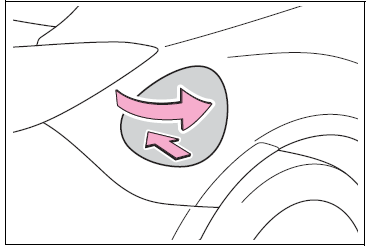
- Turn the fuel tank cap slowly and remove it, then put it into the holder on the fuel filler door.

When opening the fuel filler door
The fuel filler door cannot be opened if the doors have been unlocked using an inside lock button. Unlock the doors using the entry function, wireless remote control, or door lock switch.
Read all Instructions for Refueling User Guide
Toyota 86 2022 EyeSight User Guide
2022 Toyota 86 EyeSight User Guide
EyeSight 1, 2
- If Equipped
- EyeSight is a registered trademark of SUBARU CORPORATION.
EyeSight is a driving support system that uses a range of functions to assist the driver in making decisions in order to provide for more safe and more comfortable driving and to reduce driver fatigue. Making use of images created by the stereo camera, EyeSight detects vehicles, obstacles, traffic lanes, and other items ahead. EyeSight records and stores the following data when Pre-Collision Braking System is operated. It does not record conversations or other audio data.
- Stereo camera image data
- Distance from the vehicle in front
- Vehicle speed
- Steering wheel turning angle
- Lateral movement with regards to the direction of travel
- Accelerator pedal operation status
- Brake pedal operation status
- Shift lever position
- Odometer reading
- Data related to ABS, VSC and TRAC
Toyota and third parties contracted by Toyota may acquire and use the recorded data for the purpose of vehicle research and development. Toyota and third parties contracted by Toyota will not disclose or provide the acquired data to any other third party except under the following conditions.
- The vehicle owner has given his/her consent.
- The disclosure/provision is based on a court order or other legally enforceable request.
- Data that has been modified so that the user and vehicle cannot be identified is provided to a research institution for statistical processing or similar purposes.
WARNING
Drivers are responsible for driving safely. Always comply with all traffic rules and regulations regardless of the fact that your vehicle is equipped with EyeSight. Always maintain a safe following distance between your vehicle and the vehicle in front of you, pay attention to your surroundings and driving conditions, and take necessary actions in order to maintain a safe following distance. Never attempt to drive relying on EyeSight alone. EyeSight is intended to assist the driver in making decisions in order to reduce the risk of accidents or damage and lessen the burden on the driver. When an EyeSight warning is activated, pay attention to what is in front of you and to your surroundings, and take necessary actions. This system is not designed to support driving in poor visibility or in extreme weather conditions or to protect against careless driving when the driver is not paying complete attention to the road ahead. It also cannot prevent collisions from occurring in all driving conditions.
WARNING
There are limits to the EyeSight recognition performance and control performance. Be sure to read the instructions for each function before using the system, and always use it properly. Improper use may lead to failure of control performance, which could cause an accident. Refer to the following pages for each function:
- For Pre-Collision Braking System
- For Adaptive Cruise Control
- For Conventional Cruise Control
- For Pre-Collision Throttle Management
- For Lane Departure Warning
- For Lane Sway Warning
- For Lead Vehicle Start Alert
In left-hand drive vehicles, Eye-Sight is configured for driving on the right-hand side of the road. However, it can be reconfigured by changing the driving lane setting for driving on the left-hand side.* If the setting for the traffic lane (driving side of the road) does not match the traffic lane, full Eye-Sight performance may not be available. Characteristics and settings that are affected by specific differences between right-hand drive and left-hand drive vehicles cannot be changed.
The system may not operate correctly under the conditions listed below. When these conditions occur, turn off the Pre-Collision Braking System. Also, do not use Adaptive Cruise Control or Conventional Cruise Control.
Read all Instructions for EyeSight User Guide
Toyota 86 2022 Using other driving systems and Driving tips User Guide
Driving Tips : 2022 Toyota 86 Breaking Features User Guide
BSD/RCTA
The BSD/RCTA consists of rear corner radars with Blind Spot Detection, Lane Change Assist and Rear Cross Traffic Alert. These functions of BSD/RCTA are the systems that detect objects and vehicles to the rear and draw attention to the driver when changing a lane or when driving in reverse.
WARNING
The driver is responsible for driving safely. Always be sure to check the surroundings with your eyes when changing lanes or reversing the vehicle. The system is designed to assist the driver in changing lanes or reversing safely by monitoring the rear and side areas of the vehicle. However, you cannot rely on this system alone in assuring the safety during a lane change or reversing. Overconfidence in this system could result in an accident and lead to serious injury or death. Since the system operation has various limitations, the flashing or illumination of the BSD/RCTA approach indicator may be delayed or it may not operate at all even when a vehicle is present in a neighboring lane or approaching from either side. The driver is responsible for paying attention to the rear and side areas of the vehicle.
System features
BSD/RCTA consists of the following functions.
- To detect a vehicle in a blind spot on an adjacent lane or a vehicle approaching at high speed while driving the vehicle (Blind Spot Detection) To detect a vehicle approaching from the right or left while reversing the vehicle (Rear Cross Traffic Alert)
The system uses radar sensors for the following features. The BSD/RCTA radar sensor has been certified by the radio wave related laws of the U.S. and other FCC compliant countries and Canada. When driving in other countries, certification of the country where the vehicle is driven must be obtained. For certification in the U.S. and other FCC compliant countries and Canada, refer to
Blind Spot Detection (BSD)
- The system notifies the driver of the presence of vehicles in its blind spot.
- If the system detects a vehicle in its blind spot, it warns the driver by illuminating the BSD/RCTA approach indicator( s) on the outside mirror(s).
- If the driver operates the turn signal lever in the direction where the BSD/RCTA approach indicator is illuminating, the system warns the driver of dangers by flashing the BSD/RCTA approach indicator.

- (A) Operating range
Lane Change Assist (LCA)
- The system notifies the driver of vehicles approaching at a high speed in the neighboring lanes.
- If the system detects a vehicle approaching at a high speed in the neighboring lanes, it warns the driver of dangers by illuminating the BSD/RCTA approach indicator(s) on the outside mirror(s).
- If the driver operates the turn signal lever in the direction where the BSD/RCTA approach indicator is illuminating, the system warns the driver of dangers by flashing the BSD/RCTA approach indicator

- (A) Operating range
Rear Cross Traffic Alert (RCTA)
The system notifies the driver of another vehicle approaching from either side when driving in reverse. This feature helps the driver check the rear and side areas of the vehicle when moving backward. If the system detects a vehicle approaching from either side while moving backward, it warns the driver of dangers in the following way.
- The BSD/RCTA approach indicator(s) on the outside mirror(s) flashes.
- A warning buzzer sounds.
- An icon appears on the multimedia system screen
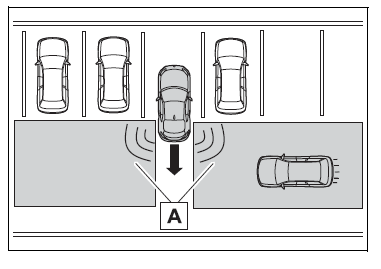
- (A) Operating range
Limitations of the detectability of RCTA
Since the detectability of RCTA is limited, the RCTA may not operate properly in angled parking.
Example 1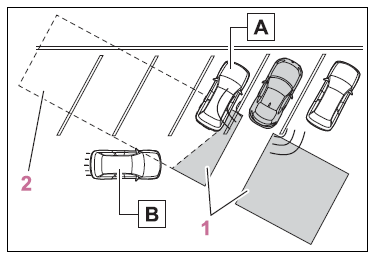
- The detection range of the radar sensors
- Area out of detection range of the radar sensors
(A) Parked vehicle
(B) Vehicle that may not be detected
WARNING
An approaching vehicle may not be detected because the detection range is limited by the parked vehicle . Always be sure to check the surroundings with your eyes when reversing the vehicle.
Read all Instructions for Using other driving systems and Driving tips User Guide
Toyota 86 2022 Interior features User Guide
2022 Toyota 86 Air Conditioning Controls | Interior Features Guide
Automatic air conditioning system
Air outlets are automatically selected and fan speed is automatically adjusted according to the set temperature setting
Air conditioning controls
- Left-hand side temperature setting display
- Left-hand side temperature control switch
- Climate control mode display
- Fan speed control switch
- Right-hand side temperature control switch
- Right-hand side temperature setting display
- “MAX A/C” switch
- “SYNC” switch
- Outside/recirculated air mode switch
- “A/C” switch
- Airflow mode control switch
- Rear window defogger and outside rearview mirror defoggers switch
- “ON/OFF” switch
- Windshield defogger switch
- Automatic mode switch
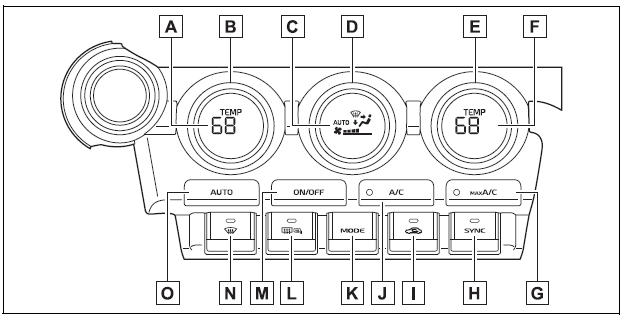
Adjusting the temperature setting
To adjust the temperature setting, turn the temperature control switch clockwise (warm) or counterclockwise (cool). If “A/C” switch is not pressed, the system will blow ambient temperature air or heated air. The air conditioning system switches between individual and synchronized modes each time “SYNC” switch is pressed. Synchronized modes (indicator on): The left-hand side temperature control switch can be used to adjust the temperature for the driver’s and front passenger’s side. At this time, operate the right-hand side temperature control switch to enter individual mode. Individual modes (indicator off): The temperature for the driver’s and front passenger’s side can be adjusted separately.
Setting the fan speed
To adjust the fan speed, turn the fan speed control switch clockwise (increase) or counterclockwise (decrease). Pressing the “ON/OFF” switch to turns off the fan.
Change the airflow mode
Press the airflow mode control switch. The airflow mode changes as follows each time the switch is pressed.
- Upper body
- Upper body and slightly to the feet
- Upper body and feet
- Feet
- Feet and the windshield defogger operates
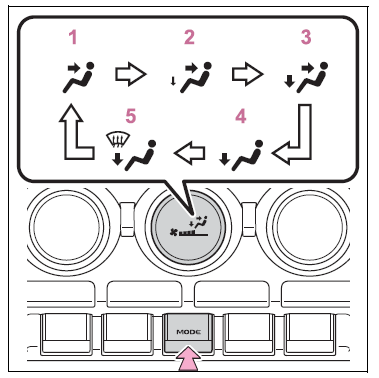
Switching between outside air and recirculated air modes
Press the outside/recirculated air mode switch. The mode switches between outside air mode and recirculated air mode each time the switch is operated. When recirculated air mode is selected, the indicator illuminates on the outside/recirculated air mode switch.
Set cooling and dehumidification function
Press the “A/C” switch. When the function is on, the indicator illuminates on the “A/C” switch.
Fast cooling function
Press the “MAX A/C” switch. When the switch is turned on, the air conditioning will turn on, the temperature will be set to LO, the fan speed will be set to MAX, the air outlets will be set to upper body, and the air mode will change to recirculated air mode automatically. To turn off the fast cooling function and return to the previous setting, press the “MAX A/C” switch again.
Suspend function
Press the “ON/OFF” switch. While the air conditioning system is being used, when the “ON/OFF” switch is pressed, the air conditioning system will stop and the temperature setting display, etc. will turn off. If the “ON/OFF” switch is pushed and turned on, the air conditioning system will operate in the operating state it was in when turned off. However, if the fast cooling function was operating when the air conditioning system was turned off, it will operate in the operating state it was in before the fast cooling function was turned on.
Defogging the windshield
Defoggers are used to defog the windshield and front side windows. Press the windshield defogger switch. Set the outside/recirculated air mode switch to outside air mode if the recirculated air mode is used. (Changes automatically) To defog the windshield and the side windows quickly, turn the airflow and temperature up. To return to the previous mode, press the windshield defogger switch again when the windshield is defogged. When the windshield defogger switch is on, the indicator illuminates the windshield defogger switch.
Defogging the rear window and outside rearview mirrors
Defoggers are used to defog the rear window, and to remove raindrops, dew, and frost from the outside rearview mirrors. Press the rear window and outside rearview mirror defoggers switch. The defoggers will automatically turn off after approximately 15 minutes. When the rear window and outside rearview mirror defoggers switch is on, the indicator illuminates on the rear window and outside rearview mirror defoggers switch.
Read all Instructions for Interior features User Guide
Toyota 86 2022 Maintenance and care User Guide
2022 Toyota 86 Maintenance | Interior Care User Guide
Cleaning and protecting the vehicle exterior
Perform cleaning in a manner appropriate to each component and its material
Cleaning instructions
- Working from top to bottom, liberally apply water to the vehicle body, wheel wells, and underside of the vehicle to remove any dirt and dust.
- Wash the vehicle body using a sponge or soft cloth, such as a chamois.
- If very dirty, use a car wash soap that does not contain abrasives and then thoroughly rinse with water.
- Wipe away any water.
- Wax the vehicle when the waterproof coating deteriorates.
- If water does not bead on a clean surface, apply wax when the vehicle body is cool.
Automatic car washes
- Fold the mirrors before washing the vehicle. Start washing from the front of the vehicle. Make sure to extend the mirrors before driving.
- Brushes used in automatic car washes may scratch the vehicle surface, and parts (wheel, etc.) and harm your vehicle’s paint.
High-pressure car washes
- As water may enter the cabin, do not bring the nozzle tip near the gaps around the doors or perimeter of the windows, or spray these areas continuously.
When using a car wash
- If the door handle becomes wet while the electronic key is within the effective range, the door may lock and unlock repeatedly.
- In that case, follow the following correction procedures to wash the vehicle:
- Place the key in a position 6 ft. (2 m) or more separate from the vehicle while the vehicle is being washed.
- (Take care to ensure that the key is not stolen.)
- Set the electronic key to battery-saving mode to disable the smart key system.
Wheels and wheel ornaments (vehicles without matte painted wheels)
- remove any dirt immediately by using a neutral detergent.
- Wash detergent off with water immediately after use.
- To protect the paint from damage, make sure to observe the following precautions.
- Do not use acidic, alkaline or abrasive detergent
- Do not use hard brushes
- Do not use detergent on the wheels when they are hot, such as after driving or parking in hot weather
Wheels and wheel ornaments (vehicles with matte-painted wheels)
- As matte-painted wheels require different cleaning methods than conventional wheels, be sure to observe the following. For details, consult your Toyota dealer.
- Remove dirt using water. If the wheels are excessively dirty, use a sponge or soft cloth dampened with a diluted neutral detergent to remove the dirt.
- To protect the matte paint from damage, make sure to observe the following precautions.
- Do not scrub or polish the wheels using a brush or dry cloth
- Do not use any wheel coatings or abrasive detergents
Brake pads and calipers
- Rust may form if the vehicle is parked with wet brake pads or disc rotors, causing them to stick. Before parking the vehicle after it is washed, drive slowly and apply the brakes several times to dry the parts
Bumpers
- Do not scrub with abrasive cleaners.
Plated portions
- If dirt cannot be removed, clean the parts as follows:
- Use a soft cloth dampened with an approximately 5% solution of neutral detergent and water to clean the dirt off.
- Wipe the surface with a dry, soft cloth to remove any remaining moisture.
- To remove oily deposits, use alcohol-wet wipes or a similar product.
WARNING
- When washing the vehicle Do not apply water to the inside of the engine compartment.
- Doing so may cause the electrical components, etc. to catch fire. exhaust pipes Exhaust gasses cause the exhaust pipes and rear bumper diffusers to become quite hot.
- When washing the vehicle, be careful not to touch the pipes and diffusers until they have cooled sufficiently, as touching hot exhaust pipes and rear bumper diffusers can cause burns.
- Precaution regarding the rear bumper If the paint of the rear bumper is chipped or scratched, the following systems may not function correctly.
- If this occurs, consult your Toyota dealer.
- BSD/RCTA (if equipped)
- RAB (if equipped)
NOTICE
- To prevent paint deterioration and corrosion on the body and components (aluminum wheels, etc.)
- Wash the vehicle immediately in the following cases:
- After driving near the sea coast
- After driving on salted roads
- If coal tar or tree sap is present on the paint surface
- If dead insects, insect droppings or bird droppings are present on the paint surface
- After driving in an area contaminated with soot, oily smoke, mine dust, iron powder or chemical substances
- If the vehicle becomes heavily soiled with dust or mud.
Read all Instructions for Maintenance and care User Guide
Toyota 86 2022 Maintenance User Guide
2022 Toyota 86 Scheduled Engine Maintenance User Manual
Maintenance requirements
To ensure safe and economical driving, day-to-day care and regular maintenance are essential. It is the owner’s responsibility to perform regular checks. Toyota recommends the following maintenance:
Repair and replacement
It is recommended that genuine Toyota parts be used for repairs to ensure the performance of each system. If non-Toyota parts are used in replacement or if a repair shop other than a Toyota dealer performs repairs, confirm the warranty coverage.
Allow inspection and repairs to be performed by a Toyota dealer
- Toyota technicians are well-trained specialists and are kept up to date with the latest service information. They are well informed about the operations of all systems on your vehicle.
- Keep a copy of the repair order. It proves that the maintenance that has been performed is under warranty coverage. If any problem should arise while your vehicle is under warranty, your Toyota dealer will promptly take care of it.
WARNING
- If your vehicle is not properly maintained
Improper maintenance could result in serious damage to the vehicle and possible death or serious injury. - Handling of the battery
- Engine exhaust, some of its constituents, and a wide variety of automobile components contain or emit chemicals known to the State of California to cause cancer and birth defects and other reproductive harm. Work in a well-ventilated area.
- Oils, fuels and fluids contained in vehicles as well as waste produced by component wear contain or emit chemicals known to the State of California to cause cancer and birth defects or other reproductive harm. Avoid exposure and wash any affected area immediately.
- Battery posts, terminals and related accessories contain lead and lead compounds which are known to cause brain damage. Wash your hands after handling.
General maintenance
General maintenance should be performed on a daily basis. This can be done by yourself or by a Toyota dealer.
Scheduled maintenance
Scheduled maintenance should be performed at specified intervals according to the maintenance schedule. For details about maintenance items and schedules, refer to the “Scheduled Maintenance Guide” or “Owner’s Manual Supplement”.
Do-it-yourself maintenance
You can perform some maintenance procedures by yourself. Please be aware that do-it-yourself maintenance may affect warranty coverage. The use of Toyota repair manuals is recommended. For details about warranty coverage, refer to the separate “Owner’s Warranty Information Booklet” or “Owner’s Manual Supplement”.
General maintenance
Listed below are the general maintenance items that should be performed at the intervals specified in the “Owner’s Warranty Information Booklet” or “Owner’s Manual Supplement/Scheduled Maintenance Guide”. It is recommended that any problem you notice should be brought to the attention of your Toyota dealer or qualified service shop for advice.
WARNING
If the engine is running Turn the engine off and ensure that there is adequate ventilation before performing maintenance checks.
Engine compartment
| Items | Check points |
| Battery | Check the connec- tions. |
| Brake fluid/Clutch fluid | Is the brake fluid and clutch fluid at the correct level? |
|
Engine coolant |
Is the engine cool- ant at the correct level? |
|
Engine oil |
Is the engine oil at the correct level? |
| Items | Check points |
| Exhaust sys- tem | There should not be any fumes or strange sounds. |
|
Radiator/con- denser |
The radiator and condenser should be free from for- eign objects. |
|
Washer fluid |
Is there sufficient washer fluid? |
Vehicle interior
| Items | Check points |
|
Accelerator pedal |
• The accelerator pedal should move smoothly (without uneven pedal effort or catching). |
|
Automatic transmission “Park” mecha- nism |
• When parked on a slope and the shift lever is in P, is the vehicle securely stopped? |
|
Brake pedal |
• Does the brake pedal move smoothly?
• Does the brake pedal have appropriate clearance from the floor? • Does the brake pedal have the correct amount of free play? |
| Items | Check points |
|
Brakes |
• The vehicle should not pull to one side when the brakes are applied.
• The brakes should work effectively. • The brake pedal should not feel spongy. • The brake pedal should not get too close to the floor when the brakes are applied. |
|
Clutch pedal |
• Does the clutch pedal move smoothly?
• Does the clutch pedal have appropriate clearance from the floor? • Does the clutch pedal have the correct amount of free play? |
|
Head restraints |
• Do the head restraints move smoothly and lock securely? |
|
Indica- tors/buzzers |
• Do the indica- tors and buzzers function prop- erly? |
| Lights | • Do all the lights come on? |
| Items | Check points |
|
Parking brake |
• Does the park- ing brake move smoothly?
• When parked on a slope and the parking brake is on, is the vehicle securely stopped? |
|
Seat belts |
• Do the seat belts operate smoothly?
• The seat belts should not be damaged. |
|
Seats |
• Do the seat con- trols operate properly? |
|
Steering wheel |
• Does the steer- ing wheel rotate smoothly?
• Does the steer- ing wheel have the correct amount of free play? • There should not be any strange sounds coming from the steer- ing wheel. |
Read all Instructions for Maintenance User Guide
Toyota 86 2022 Do-it-yourself maintenance User Guide
2022 Toyota 86 Maintenance | Tips and Services Guide
Do-it-yourself service precautions
If you perform maintenance by yourself, be sure to follow the correct procedure as given in these sections
Maintenance
| Items | Parts and tools |
|
Battery condition |
• Warm water
• Baking soda • Grease • Conventional wrench (for ter- minal clamp bolts) |
|
Brake fluid and Clutch fluid level |
• SAE J1703 or FMVSS No.116 DOT 3 brake fluid
• Rag or paper towel • Funnel (used only for adding brake fluid and clutch fluid) |
| Items | Parts and tools |
|
Engine cool- ant level |
• “TOYOTA Genu- ine 50/50
Pre-mixed Super Long Life Cool- ant BLUE” or a similar high qual- ity ethylene gly- col-based non-silicate, non-amine, non-nitrite and non-borate cool- ant with long-life hybrid organic acid technology. • For the U.S.A.: “TOYOTA Genu- ine 50/50 Pre-mixed Super Long Life Cool- ant BLUE” is pre-mixed with 50% coolant and 50% deionized water. • For Canada: “TOYOTA Genu- ine 50/50 Pre-mixed Super Long Life Cool- ant BLUE” is pre-mixed with 55% coolant and 45% deionized water. • Funnel (used only for adding coolant) |
| Items | Parts and tools |
|
Engine oil level |
• “Toyota Genuine Motor Oil” or equivalent
• Rag or paper towel • Funnel (used only for adding engine oil) |
| Fuses | • Fuse with same amperage rating as original |
|
Light bulbs |
• Bulb with same number and wattage rating as original
• Phillips-head screwdriver • Flathead screw- driver |
| Radiator and condenser |
¾ |
| Tire inflation pressure | • Tire pressure gauge
• Compressed air source |
|
Washer fluid |
• Water or washer fluid containing antifreeze (for winter use)
• Funnel (used only for adding water or washer fluid) |
Read all Instructions for Do-it-yourself maintenance User Guide
Toyota 86 2022 When trouble arises User Guide
Towing Tips: 2022 Toyota 86 Emergency Flashers User Manual
Emergency flashers
The emergency flashers are used to warn other drivers when the vehicle has to be stopped on the road due to a breakdown, etc.
Operating instructions
Press the switch. All the turn signal lights will flash. To turn them off, press the switch once again
Emergency flashers
If the emergency flashers are used for a long time while the engine is not operating, the battery may discharge.
If your vehicle has to be stopped in an emergency
Only in an emergency, such as if it becomes impossible to stop the vehicle in the normal way, stop the vehicle using the following procedure
Stopping the vehicle
- Steadily step on the brake pedal with both feet and firmly depress it.
- Do not pump the brake pedal repeatedly as this will increase the effort required to slow the vehicle.
- Shift the shift lever to N.
- If the shift lever is shifted to N
- After slowing down, stop the vehicle in a safe place by the road.
- Stop the engine.
- If the shift lever cannot be shifted to N
- Keep depressing the brake pedal with both feet to reduce vehicle speed as much as possible.
- To stop the engine, press and hold the engine switch for 2 consecutive seconds or more, or press it briefly 3 times or more in succession Stop the vehicle in a safe place by the road.
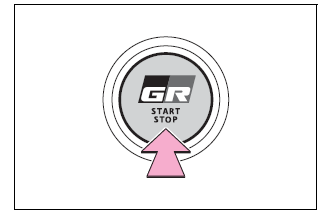
WARNING
If the engine has to be turned off while driving Power assist for the brakes and steering wheel will be lost, making the brake pedal harder to depress and the steering wheel heavier to turn. Decelerate as much as possible before turning off the engine.
If the vehicle is submerged or water on the road is rising
This vehicle is not designed to be able to drive on roads that are deeply flooded with water. Do not drive on roads where the roads may be submerged or the water may be rising. It is dangerous to remain in the vehicle, if it anticipated that the vehicle will be flooded or set a drift. Remain calm and follow the following.
- If the door can be opened, open the door and exit the vehicle.
- If the door cannot be opened, open the window using the power window switch and ensure an escape route.
- If the window can be opened, exit the vehicle through the window.
- If the door and window cannot be opened due to the rising water, remain calm, wait until the water level inside the vehicle rises to the point that the water pressure inside of the vehicle equals the water pressure outside of the vehicle and then open the door after waiting for the rising water to enter the vehicle, and exit the vehicle. When the outside water level exceeds half the height of the door, the door cannot be opened from the inside due to water pressure.
Water level exceeds the floor
When the water level exceeds the floor and time has passed, the electrical equipment will get damaged, the power windows will not operate, the engine stop, and the vehicle may not be able to get moving.
Read all Instructions for When trouble arises User Guide
Toyota 86 2022 Specifications User Guide
Toyota 86 2022 Specifications User Guide
Maintenance data (fuel, oil level, etc.)
Dimensions and weight
| Overall length | 167.9 in. (4265 mm) | |
| Overall width | 69.9 in. (1775 mm) | |
| Overall height* | 51.6 in. (1310 mm) | |
| Wheelbase | 101.4 in. (2575 mm) | |
|
Tread |
Front | 59.8 in. (1520 mm) |
| Rear | 61.0 in. (1550 mm) | |
| Vehicle capacity weight (Occupants + lug- gage) | Details are described on the tire and loading information label. | |
Seating capacity
Seating capacity 4 (Front 2, Rear 2)
Vehicle identification
- Vehicle identification number The vehicle identification number (VIN) is the legal identifier for your vehicle. This is the primary identification number for your Toyota. It is used in registering the ownership of your vehicle.
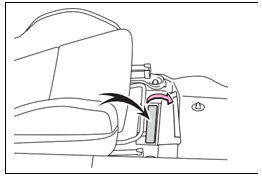
- This number is stamped under the right-hand front seat. This number is located on the top left of the body panel
- This number is also on the Certification Label. The vehicle model type, vehicle identification number, etc. are on the manufacturer’s label

Engine number
The engine number is stamped on the engine block as shown
Engine
| Model | FA24 |
| Type | Horizontally opposed, liquid cooled 4 cylinder, 4-stroke gasoline |
| Bore and stroke | 3.70 ´ 3.39 in. (94.0 ´ 86.0 mm) |
| Displacement | 146 cu. in. (2387 cm3) |
| Drive belt tension | Automatic adjustment |
Fuel
| Fuel type | Unleaded gasoline only |
| Octane Rating | 93 (Research octane number 98) or higher* |
| Fuel tank capacity (Reference) | 13.2 gal. (50.0 L, 11.0 Imp. gal.) |
Lubrication system
Oil capacity (Drain and refill (Reference)
The engine oil capacity is a reference quantity to be used when changing the engine oil. Warm up and turn off the engine, wait more than 5 minutes, and check the oil level on the dipstick
| With filter | 5.3 qt. (5.0 L, 4.4 Imp. qt.) |
| Without filter | 5.1 qt. (4.8 L, 4.2 Imp. qt.) |
Engine oil selection
“Toyota Genuine Motor Oil” is used in your Toyota vehicle. Use Toyota approved “Toyota Genuine Motor Oil” or equivalent to satisfy the following grade and viscosity. Oil grade: ILSAC GF-6A multigrade engine oil Recommended viscosity: SAE 0W-20 SAE 0W-20 is the best choice for good fuel economy and good starting in cold weather. If SAE 0W-20 is not available, SAE 5W-20 oil may be used. However, it must be replaced with SAE 0W-20 at the next oil change.
Outside temperature
Oil viscosity (0W-20 is explained here as an example):
- The 0W in 0W-20 indicates the characteristic of the oil which allows cold startability. Oils with a lower value before the W allow for easier starting of the engine in cold weather.
- The 20 in 0W-20 indicates the viscosity characteristic of the oil when the oil is at high temperature. An oil with a higher viscosity (one with a higher value) may be better suited if the vehicle is operated at high speeds, or under extreme load conditions.
Read all Instructions for Specifications User Guide
Toyota 86 2022 Customization User Guide
Toyota 86 2022 Customization User Guide
Customizable features
Your vehicle includes a variety of electronic features that can be personalized to suit your preferences. The settings of these features can be changed by using the steering wheel switches, navigation system, multimedia system or at your Toyota dealer. It is also possible to customize certain vehicle features yourself using the multi-information display
Customizing vehicle features
Changing by using the multimedia system screen
- Press

- Select

- If the select

- If the select
- Select “General” or “Car”.
- Select the preferred menu.
For details on the multimedia system, refer to the “MULTIMEDIA OWNER’S MANUAL”.
Changing by using the meter control switches
- Press
 of the meter control switch to select
of the meter control switch to select 
- Press
 the meter control switch to select the desired item to be customized.
the meter control switch to select the desired item to be customized. - Press

WARNING
- During customization
- As the engine needs to be running during customization, ensure that the vehicle is parked in a place with adequate ventilation.
- In a closed area such as a garage, exhaust gases including harmful carbon monoxide (CO) may collect and enter the vehicle. This may lead to death or a serious health hazard.
NOTICE
- During customization
- To prevent battery discharge, ensure that the engine is running while customizing features
Customizable features
Some function settings are changed simultaneously with other functions being customized. Contact your Toyota dealer for further details.
- Settings that can be changed using the multimedia system screen
- Settings that can be changed using the meter control switches
- Settings that can be changed by your Toyota dealer
Definition of symbols: O = Available, — = Not available
Alarm
| Function | Default setting | Customized set- ting |
A |
B |
C |
| Operation when doors are unlocked using the mechanical key |
Off |
On |
— |
— |
O |
Gauges, meters and multi-information display
| Function*1 | Default setting | Customized set- ting |
A |
B |
C |
|
Language |
English |
French |
O |
— |
— |
| Spanish | |||||
| Units*2 | miles, MPH, MPG | km, km/h, l/100 km | O | O | — |
| Clock | 12H | 24H | O | — | — |
| Startup screen | On | Off | O | O | — |
| GSI (Gear Shift Indica- tor)*3 | On | Off | O | O | — |
| REV. (Indicator) | Off | On | O | O | — |
| REV. (rpm) | Off (2000 rpm) | 2000 rpm¾7400 rpm | O | O | — |
| REV. (Buzzer) | Off | On | O | O | — |
| Warning Volume*4 |
Mid |
Min |
O |
O |
— |
| Max | |||||
|
Auto dimmer cancel |
3 |
Off |
— |
— |
O |
| 1 to 5 |
- For details about each function
- Vehicles with manual transmission
- On some models
Read all Instructions for Customization User Guide
Toyota 86 2022 For owners User Guide
2022 Toyota 86 SRS Airbags Features User Guide
Reporting safety defects for U.S. owners
If you believe that your vehicle has a defect that could cause a crash or could cause injury or death, you should immediately inform the National Highway Traffic Safety Administration (NHTSA) in addition to notifying Toyota Motor Sales, U.S.A., Inc. (Toll-free: 1-800- 331-4331). If NHTSA receives similar complaints, it may open an investigation, and if it finds that a safety defect exists in a group of vehicles, it may order a recall and remedy campaign. However, NHTSA cannot become involved in individual problems between you, your dealer, or Toyota Motor Sales, U.S.A., Inc. To contact NHTSA, you may call the Vehicle Safety Hotline toll-free at 1-888-327-4236 (TTY: 1-800-424-9153); go to http://www.safercar.gov; or write to Administrator, NHTSA, 1200 New Jersey Ave. SE., Washington, DC 20590. You can also obtain other information about motor vehicle safety from http://www.safercar.gov
Reporting safety defects for Canadian owners
Canadian customers who wish to report a safety-related defect to Transport Canada, Defects Investigations and Recalls, may telephone the toll-free hotline 1-800-333-0510, mail Transport Canada – ASFAD, 330 Sparks Street, Ottawa, ON, K1A 0N5, or complete the online form at https://www.tc.gc.ca/recalls
Seat belt instructions for Canadian owners (in French)
The following is a French explanation of seat belt instructions extracted from the seat belt section in this manual. See the seat belt section for more detailed seat belt instructions in English
Correct use of seat belts
- Unroll the diagonal strap so that it goes well on the shoulder, without be in contact with the neck or slip off the shoulder.
- Position the abdominal strap as low as possible on the hips.
- Adjust the position of the seatback. Sit with your back straight as possible and sit well in the seat.
- Do not twist the seat belt.
Maintenance and care
Seat belt treatment Clean with a cloth or sponge dampened with warm soapy water. Regularly check that the belts are not excessively worn, frayed or cut.
WARNINGSeat belt damage and wear Inspect the seat belt system regularly. Check for cuts, fraying and loose parts. Do not use a damaged seat belt until it has been replaced. A damaged seat belt will not protect an occupant from serious or fatal injury.
SRS airbag instructions for Canadian owners (in French)
The following is a French explanation of SRS airbag instructions extracted from the SRS airbag section in this manual. See the SRS airbag section for more detailed SRS airbag instructions in English.
Components
Location of SRS airbags The SRS airbags are located in the following locations
- Driver’s SRS front airbag: in the center of the steering wheel “SRS AIRBAG” is affixed to the airbag trim.
- Front passenger’s SRS frontal airbag: near the upper right side of the dashboard There is an inscription “SRS AIRBAG” on the right corner of the dashboard
- SRS side airbag: in the door side of each front seat backrest “SRS AIRBAG” markings are affixed to the door side of each front seat cushion.
- SRS curtain airbag: on the roof side (between the front pillar and a point above the rear seat) “SRS AIRBAG” markings are affixed to the top of each central pillar.
- SRS knee airbag: under the steering column An “SRS AIRBAG” inscription is affixed to the level of the airbag cover.

Read all Instructions for For owners User Guide
Toyota 86 2022 what to do if (Troubleshooting) User Guide
2022 Toyota 86 Keys Troubleshooting | Tips and Technique Guide
What to do if (Troubleshooting)
If you have a problem, check the following before contacting your Toyota dealer. The doors cannot be locked, unlocked, opened or closed
 You lose your keys
You lose your keys
- If you lose your mechanical keys, new genuine mechanical keys can be made by your Toyota dealer.
- If you lose your electronic keys, the risk of vehicle theft increases significantly. Contact your Toyota dealer immediately.
 The electronic key does not operate properly
The electronic key does not operate properly
- Is the electronic key battery weak or depleted?
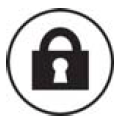 The doors cannot be locked or unlocked
The doors cannot be locked or unlocked
- Is the engine switch in ON?
- When locking the doors, turn the engine switch off.
- Is the electronic key left inside the vehicle?
- When locking the doors, make sure that you have the electronic key on your person.
- The function may not operate properly due to the condition of the radio wave.
 The trunk lid is closed with the electronic key left inside
The trunk lid is closed with the electronic key left inside
- The function to prevent the electronic key from being left inside the trunk will operate and you can open the trunk as usual. Take the key out from the trunk
If you think something is wrong
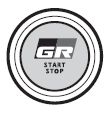 The engine does not start
The engine does not start
- Automatic transmission: Did you press the engine switch while firmly depressing the brake pedal?
- Manual transmission: Did you press the engine switch while firmly depressing the clutch pedal?
- Automatic transmission: Is the shift lever in P?
- Is the electronic key anywhere detectable inside the vehicle?
- Is the steering wheel unlocked?
- Is the electronic key battery weak or depleted? In this case, the engine can be started in a temporary way.
- Is the battery discharged?
 The shift lever cannot be shifted from P even if you depress the brake pedal (Automatic transmission
The shift lever cannot be shifted from P even if you depress the brake pedal (Automatic transmission
- Is the engine switch in ON?
- If you cannot release the shift lever by depressing the brake pedal with the engine switch in ON.
 The steering wheel cannot be turned after the engine is stopped
The steering wheel cannot be turned after the engine is stopped
- It is locked automatically to prevent theft of the vehicle.
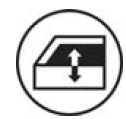 The windows do not open or close by operating the power window switches
The windows do not open or close by operating the power window switches
- Is the window lock switch pressed
- The power window except for the one at the driver’s seat cannot be operated if the window lock switch is pressed.
 The engine switch is turned off automatically
The engine switch is turned off automatically
- The auto power off function will be operated if the vehicle is left in ACC or ON (the engine is not running) for a period of time.
 A warning buzzer sounds during driving
A warning buzzer sounds during driving
- The seat belt reminder light is flashing Are the driver and the passenger wearing the seat belts?
- The brake system warning light is on Is the parking brake released?
- Depending on the situation, other types of warning buzzer may also sound.
 An alarm is activated and the horn sounds
An alarm is activated and the horn sounds
- Did anyone inside the vehicle open a door during setting the alarm?
- The sensor detects it and the alarm sounds.Do one of the following to deactivate or stop the alarm:
- Unlock the doors or open the trunk using the entry function or wireless remote control.
- Open the trunk using the entry function or wireless remote control.
- Turn the engine switch to ACC or ON, or start the engine.
 A warning buzzer sounds when leaving the vehicle
A warning buzzer sounds when leaving the vehicle
- Is the message displayed on the multi-information display? Check the message on the multi-information display
 A warning light turns on or a warning message is displayed
A warning light turns on or a warning message is displayed
- When a warning light turns on or a warning message is displayed
Read all Instructions for what to do if (Troubleshooting) User Guide
FAQ
The 2022 Toyota 86 is a sports car known for its agile handling and rear-wheel-drive performance.
The 2022 Toyota 86 is powered by a 2.4-liter flat-four engine producing 228 horsepower and 184 lb-ft of torque.
The 2022 Toyota 86 offers a choice of a 6-speed manual transmission or a 6-speed automatic transmission with paddle shifters.
Yes, the 2022 Toyota 86 comes standard with rear-wheel drive, which enhances its sporty handling characteristics.
The 2022 Toyota 86 can accelerate from 0 to 60 mph in around 6 seconds, depending on the transmission and other factors.
No, the 2022 Toyota 86 is available as a coupe with a fixed roof.
The 2022 Toyota 86 is typically available in two main trim levels: base and Premium.
The 2022 Toyota 86 features sport-tuned suspension, a limited-slip differential, and a lightweight chassis for responsive handling.
The 2022 Toyota 86 focuses on the driving experience and performance, and it does not come equipped with advanced driver-assistance features like adaptive cruise control or lane-keeping assist.
The fuel economy of the 2022 Toyota 86 varies depending on the transmission choice but typically falls within the range of 21-24 mpg in the city and 28-32 mpg on the highway.
Yes, the 2022 Toyota 86 comes with a small rear seat, making it a 2+2 sports car.
The base price of the 2022 Toyota 86 can vary based on trim level and options but generally starts around the mid-$20,000 range.
The 2022 Toyota 86 typically comes with a manual parking brake, which adds to the sporty driving experience.
Toyota offers various accessories and TRD (Toyota Racing Development) performance parts to enhance the 86’s performance and appearance.
Yes, the 2022 Toyota 86 is a popular choice for track enthusiasts and autocross events due to its responsive handling and rear-wheel-drive layout, making it a joy to drive in spirited conditions.
Useful Link
Toyota Avalon 2022 User Manual
https://www.toyota.com/owners/resources/warranty-owners-manuals

